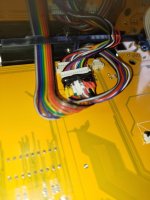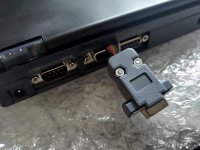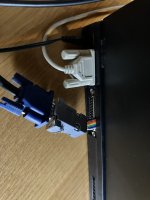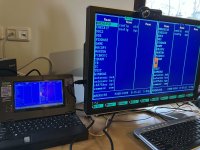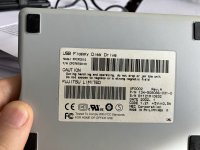Thank You! If I understand correctly, when you reconnect internal LCD, it does not operate, just blinks when the external monitor is connected, while the external monitor operates perfectly. If you unplug at that moment the external monitor, will the internal LCD switch on? If that is a case, than after installation of your wire harness it will be very easy to use the book both with the internal and external monitors, just by plugging external monitor in? As soon as your wire harness is path through, it should be the case!
Upcoming Events:
- VCF South West - June 14 - 16, Davidson-Gundy Alumni Center at University of Texas at Dallas
- VCF West - Aug 2 - 3, Computer History Museum, Mountain View, CA
- VCF Midwest - Sept 7 - 8 2024, Schaumburg, IL
- VCF SoCal - Mid February 2025, Location TBD, Southern CA
- VCF East - April 2025, Infoage Museum, Wall NJ
-
Please review our updated Terms and Rules here
- Forums
- Companies
- IBM Computers, PCs, Clones and Descendants
- PCs and Clones (XT and early AT class machines)
You are using an out of date browser. It may not display this or other websites correctly.
You should upgrade or use an alternative browser.
You should upgrade or use an alternative browser.
Book 8088 discovery and modification thread
- Thread starter Retroplayer
- Start date
n0p
Experienced Member
Thank You! If I understand correctly, when you reconnect internal LCD, it does not operate, just blinks when the external monitor is connected, while the external monitor operates perfectly. If you unplug at that moment the external monitor, will the internal LCD switch on? If that is a case, than after installation of your wire harness it will be very easy to use the book both with the internal and external monitors, just by plugging external monitor in? As soon as your wire harness is path through, it should be the case!
It's like that - no external display connnected, internal works as usual. External connected - internal somewhat disables itself, just blinks sometimes. VGA connector part will stick outside, so far i didn't get to mounting it inside.
n0p
Experienced Member
I want to thank n0p for his great aid and work - he has installed external VGA port to my Book 8088, that was what I was trying to do for a long time, but could not. The external VGA port operates perfectly, I am attaching the photos. Moreover he upgraded the BIOS of my book 8088 to version 1.07. This forum is a very good one, you can find lots of information on the subject. Thank You again.
Attachments
n0p
Experienced Member
I want to thank n0p for his great aid and work - he has installed external VGA port to my Book 8088, that was what I was trying to do for a long time, but could not. The external VGA port operates perfectly, I am attaching the photos. Moreover he upgraded the BIOS of my book 8088 to version 1.07. This forum is a very good one, you can find lots of information on the subject. Thank You again.
You're welcome!
--
Worth noting that on @Vitalii 's Book internal display stays on with external connected to my surprise.
Just got my V2 a couple of weeks ago and I'm pleased to say everything worked as expected.
(no video issues or bad solder joints)
I'd like to add a thank you to Sergey, n0p and FreddyV for their excellent contributions.
Note to anybody out there with flash drive issues. Read the instruction that come with FreddyV's driver.
The last parameter in the config.sys entry should be %0 but the one shipped has it set to %2.
So I just renamed the file and installed the new one and had lots of write problems till I fixed that.
Now it's fine.
Here's a some more photos of the V2 boards
Hope to try the boot from floppy BIOS soon and maybe the external VGA connector.
(no video issues or bad solder joints)
I'd like to add a thank you to Sergey, n0p and FreddyV for their excellent contributions.
Note to anybody out there with flash drive issues. Read the instruction that come with FreddyV's driver.
The last parameter in the config.sys entry should be %0 but the one shipped has it set to %2.
So I just renamed the file and installed the new one and had lots of write problems till I fixed that.
Now it's fine.
Here's a some more photos of the V2 boards
Hope to try the boot from floppy BIOS soon and maybe the external VGA connector.
Last edited:
Off topic - does anyone know where the break key is on the Book 8088 keyboard? I was playing with Turbo BASIC and could not stop a running program (Ctrl Break is supposed to stop a running program).
Also, I wanted to let you all know that I was able to connect the Book 8088 to the Internet and access a number of BBSs. I did it using the WiModem 232 Pro.
 www.cbmstuff.com
www.cbmstuff.com
You will need a serial port adapter for the Book 8088:
The WiModem 232 Pro is powered via the Book 8088’s USB port. I used the DOS Navigator 1.51 Terminal program and was able to get the Book 8088 surfing at 56 kbps via telnet. I tried the following popular BBSs:

 www.pcmag.com
www.pcmag.com
Also, I wanted to let you all know that I was able to connect the Book 8088 to the Internet and access a number of BBSs. I did it using the WiModem 232 Pro.
wifi modem amiga mac pc geneve tandy atari adam ti99/4a
 www.cbmstuff.com
www.cbmstuff.com
You will need a serial port adapter for the Book 8088:
The WiModem 232 Pro is powered via the Book 8088’s USB port. I used the DOS Navigator 1.51 Terminal program and was able to get the Book 8088 surfing at 56 kbps via telnet. I tried the following popular BBSs:

7 Modern BBSes Worth Calling Today
Net neutrality isn't a problem on these vintage online systems
Last edited:
Possibly related to the LCD controller firmware? Or did you update that on his too?Worth noting that on @Vitalii 's Book internal display stays on with external connected to my surprise.
n0p
Experienced Member
I didn't check the LCD board, but firmware itself worked like "Good VGA" one (no centering issues)Possibly related to the LCD controller firmware? Or did you update that on his too?
--
Regarding the firmware - i've talked a lot to DZT. So far it appears that latest (Good VGA) fw is outsourced and they cannot provide source or modify it
Not surprised they outsourced it. Probably got over their own heads. lolI didn't check the LCD board, but firmware itself worked like "Good VGA" one (no centering issues)
--
Regarding the firmware - i've talked a lot to DZT. So far it appears that latest (Good VGA) fw is outsourced and they cannot provide source or modify it
It cannot. It's tied directly to the CH375.Can the USB port be modified via the BIOS to accept a floppy disk drive?
n0p
Experienced Member
Can the USB port be modified via the BIOS to accept a floppy disk drive?
It cannot. It's tied directly to the CH375.
That might sound odd, and i'm sure that won't work out of the box, but i just viewed
Yes, and CH375 chip may or may not recognize the device on it's side as well and power supplied via chip might be insufficient for floppy drive.
Simplest way to check would be plug the drive, wait for it to settle and try to access it via CH375USB driver (best would be to use FreddyV version) on disk D.
I tried to do that. After I connected a usb floppy drive to the usb port, the computer was trying for about four minutes to add it as disk D:, but later did not find it and booted to Norton. Moreover, the green LED on USB floppy drive never lighted.That might sound odd, and i'm sure that won't work out of the box, but i just viewed- and it appears that at least device guy has *does* present itself as a USB storage device (he plugged it into Android phone). Making it work will sure require some file job on delays and wait functions, but there's a chance that might work with adjustments.
Yes, and CH375 chip may or may not recognize the device on it's side as well and power supplied via chip might be insufficient for floppy drive.
Simplest way to check would be plug the drive, wait for it to settle and try to access it via CH375USB driver (best would be to use FreddyV version) on disk D.
Attachments
n0p
Experienced Member
I tried to do that. After I connected a usb floppy drive to the usb port, the computer was trying for about four minutes to add it as disk D:, but later did not find it and booted to Norton. Moreover, the green LED on USB floppy drive never lighted.
That might mean it's not getting enough power. And the fact it was trying to detect the device is good.
Last edited:
n0p
Experienced Member
Disregard that  I've tried using USB hub and Book doesn't recognize connected devices at all. It would be interesting to try an active USB extender cable though.
I've tried using USB hub and Book doesn't recognize connected devices at all. It would be interesting to try an active USB extender cable though.
Well, that's LGR (the guy, clint) and it's also probably acting like at OTG device, which is why an android phone wouldn't have a problem with it.That might sound odd, and i'm sure that won't work out of the box, but i just viewed- and it appears that at least device guy has *does* present itself as a USB storage device (he plugged it into Android phone). Making it work will sure require some file job on delays and wait functions, but there's a chance that might work with adjustments.
Yes, and CH375 chip may or may not recognize the device on it's side as well and power supplied via chip might be insufficient for floppy drive.
Simplest way to check would be plug the drive, wait for it to settle and try to access it via CH375USB driver (best would be to use FreddyV version) on disk D.
I also tried experimenting with my USB floppy drive and the Book 8008, but I could not get it to recognize my floppy drive. There is 6 kb of free space in the BIOS from what I have read that could be used to add code to enable the floppy. It would be fantastic if we could somehow get CH375 to recognize it.
There is a USB to ISA card... Would that work? Then you would have to get an ISA floppy disk drive - not exactly as practical as a USB floppy disk drive.
There is a USB to ISA card... Would that work? Then you would have to get an ISA floppy disk drive - not exactly as practical as a USB floppy disk drive.
Loading…
www.amazon.com
n0p
Experienced Member
I also tried experimenting with my USB floppy drive and the Book 8008, but I could not get it to recognize my floppy drive. There is 6 kb of free space in the BIOS from what I have read that could be used to add code to enable the floppy. It would be fantastic if we could somehow get CH375 to recognize it.
There is a USB to ISA card... Would that work? Then you would have to get an ISA floppy disk drive - not exactly as practical as a USB floppy disk drive.
Loading…
www.amazon.com
Just to clarify - what is wrong or unacceptable (instead of floppy seek sounds, which i personally do miss) with USB floppy emulation via USB stick / thumb drive i've already put into BIOS?

